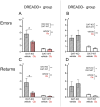Chemogenetic tools for modulation of spatial learning in dopamine transporter deficient rats
- PMID: 40761316
- PMCID: PMC12319012
- DOI: 10.3389/fnins.2025.1615208
Chemogenetic tools for modulation of spatial learning in dopamine transporter deficient rats
Abstract
Objectives: We used the chemogenetic tools for the activation of norepinephrine (NE) release in the prefrontal cortex (PFC) of dopamine transporter knockout (DAT-KO) rats. The objective of this study was to evaluate the effect of chemogenetic activation of NE release in the PFC on the performance of a spatial behavior task by DAT-KO rats. The rats DAT-KO rats with deletion of DAT gene were created as a valuable model for persistently elevated extracellular DA levels. The DAT-KO rats show marked behavioral abnormalities: impulsivity, stereotypy and reduced learning ability. Such hyperdopaminergia is thought to be one of the causes of disorders such as schizophrenia, mania and attention deficit hyperactivity disorder (ADHD). The Locus Coeruleus (LC) is a critical area in the brain that plays an important role in control of several physiological and behavioral processes due to the existence of extensive connections to cortical and subcortical structures. Its activity can modulate both norepinephrine and dopamine neurotransmission, particularly in the PFC.
Materials and methods: We used canine adenovirus type 2 (CAV2) to selectively activate LC-NA neurons in DAT-KO rats. The chemogenetic modulation of spatial learning in knockout and wild-type (WT) rats was tested in the Hebb-Williams maze. Variables such as the distance traveled, time taken to reach the goal box, number of errors and the perseverative patterns of activity were analyzed.
Results: Norepinephrine release from the LC to the PFC reduced hyperactive behavioral patterns in rats lacking the dopamine transporter (DAT-KO rats) with spontaneously elevated dopamine transmission. These manipulations in hyperdopaminergic mutants also caused amelioration of cognitive abnormalities in spatial learning task by decrease the perseverative activity and the number of visits to the error zones. Furthermore, chemogenetic activation of NE neurotransmission in these animals significantly improved their performance.
Conclusion: The results obtained in this study highlight an important modulatory role of NE transmission from LC to PFC on hyperactivity and cognitive dysfunctions of hyperdopaminergic DAT-KO rats lacking the dopamine transporter.
Keywords: Hebb-Williams maze; chemogenetic; dopamine transporter; hyperdopaminergia; knockout rats; learning.
Copyright © 2025 Gromova, Shemiakova, Khotin, Petrunina, Belskaya, Gainetdinov, Kurzina and Volnova.
Conflict of interest statement
The authors declare that the research was conducted in the absence of any commercial or financial relationships that could be construed as a potential conflict of interest.
Figures




References
-
- Adinolfi A., Zelli S., Leo D., Carbone C., Mus L., Illiano P., et al. (2019). Behavioral characterization of DAT-KO rats and evidence of asocial-like phenotypes in DAT-HET rats: the potential involvement of norepinephrine system. Behav. Brain Res. 359, 516–527. doi: 10.1016/j.bbr.2018.11.028, PMID: - DOI - PubMed
LinkOut - more resources
Full Text Sources
Research Materials
Miscellaneous

